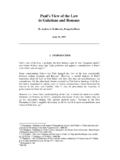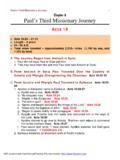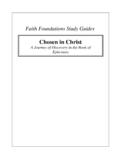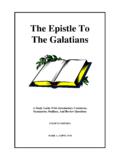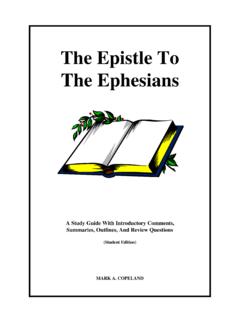Transcription of The Historical Context of Paul’s Letters To the …
1 The Historical Context of paul s LettersTo the galatians and RomansBy Andrew S. Kulikovsky (Hons)April 8, 1999 I. INTRODUCTIONNot many Letters have had such a great impact on the western world as the letter of Paulto the galatians . Indeed, this letter became the cornerstone of the It has also been called the Magna Carta of Christian liberty, and this istruly an accurate the other hand, Romans is generally regarded as the greatest of paul s Letters , andthe Roman church became one of the major centres of is therefore not surprising to find that both these great Letters are quite similar to eachother in regard to their However, their occasion and purpose are quitedifferent.
2 The purpose of this paper is to discuss the audiences to which these letterswere written, their purpose, and the Historical circumstances which prompted them to bewritten. II. AUTHORSHIP 1. GalatiansJames Montgomery Boice notes: Of the traditional Pauline books few have been sounquestioningly accepted as genuine as the Book of galatians . 5 Indeed, paul ismentioned by name as author in 1:1 and 5:2. The book is also listed as Pauline in theMarcionite and Muratorian 1 J M Boice & A S Wood, galatians - Ephesians, Expositor s Bible Commentary (Grand Rapids,Michigan: Zondervan, 1995).
3 2 E F Harrison, Romans, Expositor s Bible Commentary (Grand Rapids, Michigan: Zondervan,1995).4 F F Bruce, The Epistle to the galatians , New International Greek Testament Commentary(Grand Rapids, Michigan: Eerdmans, 1982) Boice & Wood, galatians - and Romans - Context and PurposePage 2 2. RomansThe first verse identifies paul as the author of this letter, and there has been no seriouschallenge to From the postapostolic church to the present, with almost noexception, the Epistle has been credited to paul .
4 Harrison points out that if Galatiansand 1 & 2 Corinthians are accepted as Pauline, then there is no reasonable basis fordenying that paul also wrote Romans, since it echoes much of what is said in thoseearlier , however, that 16:22 indicates paul did use a scribe. III. DATE AND LOCATION 1. GalatiansThe council of Jerusalem recorded in Acts 15 is dated to have occurred in Inlight of the discussion at the council, the letter to the galatians was most probablywritten just prior to it, since paul would have undoubtedly used the decision of thecouncil as a major argument for his defence in the this is the case, then paul would most probably have written the letter in Antioch ( 14:26-28).
5 2. RomansPaul is apparently on his way to Jerusalem with the collection from the Gentile churches(15:25-26). Acts 20:2-3 states that paul had come to Greece and stayed there for threemonths, and 2 Corinthians 13:1, 10 suggest that paul stayed at Corinth whenever hewent to Greece. Therefore, paul probably wrote the letter in This is alsosuggested by paul s commendation of Phoebe (16:1-2) who lived in Cenchrea which isadjacent to Corinth, and Gaius (16:23) may be the same person mentioned in 1 Corinthians 1:14.
6 Also, Erastus (16:23) may be the same Erastus mentioned in aninscription as a city commissioner at , the sea port adjacent to Corinth, is a less likely possibility. paul would onlyhave gone there to board a ship. But at this point in time there was a plot to kill himwhich forced him to change his plans (Acts 20:3). Therefore, it is unlikely that paul hadthe time or peace of mind at Cenchrea for composing a letter like Romans. AMacedonian origin has also been claimed, with Romans 15:25 as support, but the verbporeuo&mai can also be understood futuristically: I am about to go.
7 13 7 D Moo, Romans 1-8, Wycliffe Exegetical Commentary (Chicago: Moody Press, 1991) Harrison, G Ogg, Chronology of the Life of paul (London: Epworth, 1968) D A Carson, L Morris & D Moo, An Introduction to the New Testament (Grand Rapids,Michigan: Zondervan, 1992) Moo, H J Cadbury, Erastus of Corinth , Journal of Biblical Literature 50 (1931) Harrison, and Romans - Context and PurposePage 3 Acts 18:12 refers to Gallio, who arrived in Corinth in the summer of 51, when hebegan serving as proconsul of Achaia.
8 After this paul stayed in the city some time (Acts 18:18). Most probably the following year he went to Caesarea and Jerusalem,stopping at Antioch on the way back. Presumably, his return to Ephesus was in thebeginning of 53, marking the beginning of a three-year ministry there (Acts 20:31). Atthe end of 56 he spent three months in Corinth (Acts 20:2-3), starting his final trip toJerusalem in the beginning of 57. Therefore, the date of composition was most probablyat the beginning of 57, just before he set off for IV.
9 INTENDED RECIPIENTS 1. GalatiansFrom the historian s point of view, few NT books contain so many problems. There isno way of knowing for certain when the letter was written, where it was written, or evento whom it was people who first became known as galatians came from the barbarian tribal stockknown as the Celts, or the Gauls. They invaded Macedonia and later Asia Minor in thethird century In popular speech, these Gauls were distinguished from the West-European Gauls by the term Gallo-Graecians, from which the name galatians comes.
10 With the coming of the Romans, the territory of the galatians was incorporatedinto a much larger Roman province to which the old ethnic name, Galatia, wasextended. This province, established in 25 , contained the districts of Lycaonia andIsauria as well as portions of Pisidia and Phrygia. In particular, the cities of PisidianAntioch, Iconium, Derbe and Lystra--cities paul visited on his first missionary journey--belonged to By the first century, the province of Galatia stretched from Pontus onthe Black Sea to Pamphylia on the raises the question of whether paul s audience was situated in original Galatianterritory (North Galatia), or in Phrygian Galatia and Lycaonian Galatia (South Galatia)?

